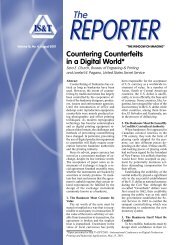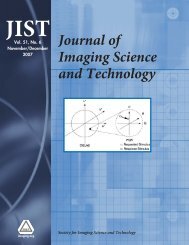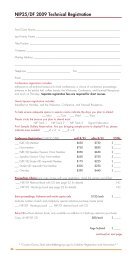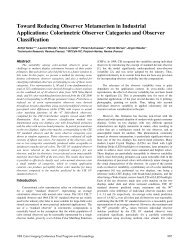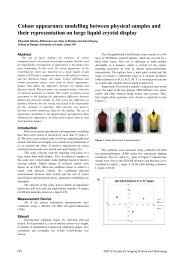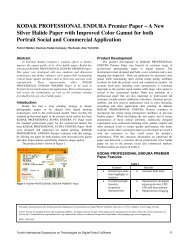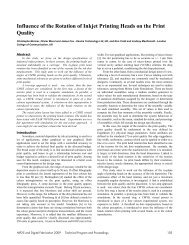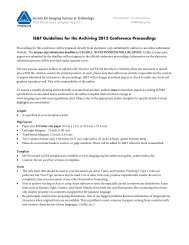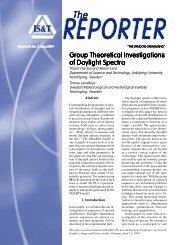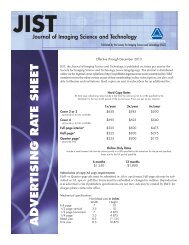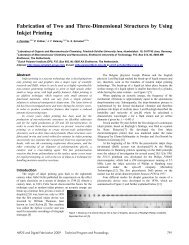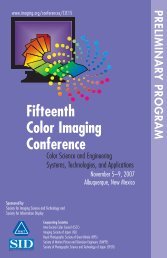JIST - Society for Imaging Science and Technology
JIST - Society for Imaging Science and Technology
JIST - Society for Imaging Science and Technology
You also want an ePaper? Increase the reach of your titles
YUMPU automatically turns print PDFs into web optimized ePapers that Google loves.
Hasan, Filosa, <strong>and</strong> Hinz: Effects of molecular substituents of copper phthalocyanine dyes on ozone fading<br />
without any polymeric binder from a donor sheet to a porous<br />
receiver. 16 The material used as donor sheets <strong>for</strong> these<br />
experiments was 4.5 m thick PET with backcoat containing<br />
lubricant suitable <strong>for</strong> thermal printing. The receiver consisted<br />
of a coating of fumed silica with a hydrophilic polymeric<br />
binder system on a polyester base. The coverage of the<br />
dyes coated on donor sheets was maintained constant<br />
285 mg/m 2 . No protective coating was transferred over<br />
the images. St<strong>and</strong>ard-type thermal printheads <strong>for</strong> monochrome<br />
prints were used <strong>for</strong> transferring the images, at<br />
maximum energy of 2.5 J/cm 2 .<br />
Figure 1. Structures of copper phthalocyanine dyes tested.<br />
Scheme 1.<br />
CuPC-D) was slowly added to the cooled solution <strong>and</strong> then<br />
allowed to warm to room temperature <strong>and</strong> stirred <strong>for</strong> 16 h.<br />
The crude reaction mixture was placed onto a plug of dry of<br />
silica gel <strong>and</strong> eluted with methylene chloride. A greenish<br />
colored material came off <strong>and</strong> was discarded. The silica with<br />
the product adhering to it was sucked down until nearly dry.<br />
The elution was continued with a mixture of ethyl acetate/<br />
hexanes, 1:1 by volume. This process removed a dark brown<br />
impurity from the product. The eluent mixture was changed<br />
to one containing 4:1 ethyl acetate/hexanes. This fraction<br />
contained the desired copper phthalocyanine dye.<br />
<strong>Imaging</strong> Method<br />
Printed images of the dyes were generated by thermally<br />
transferring the coated dyes <strong>and</strong> suitable thermal solvents,<br />
Spectra of Copper Phthalocyanine Dyes<br />
Absorption spectra of the dyes in solution were obtained,<br />
after dissolving the dyes in methylene chloride, using a<br />
HP8452A diode array spectrophotometer. The reflection<br />
spectra of the dyes were measured at the D max regions of<br />
printed images of the dyes, using a Gretag SPM500 densitometer.<br />
The conditions <strong>for</strong> the measurements were:<br />
illuminationD50, observer angle2°, density<br />
st<strong>and</strong>ardANSI A, reflection st<strong>and</strong>ardwhite base, <strong>and</strong> no<br />
filter.<br />
Ozone Stability Test Method<br />
To evaluate the ozone stability of the synthesized CuPC dyes<br />
containing various substituents, as well as the commercially<br />
available CuPC dye, the D max regions of the transferred images<br />
were exposed in an ozone chamber constructed from a<br />
Pyrex jar 1.2 ft 3 <strong>and</strong> a mercury-argon lamp. 17 Ozone was<br />
produced in situ by the direct photolysis of oxygen in the<br />
ambient air within the chamber. A fan within the chamber<br />
ensured that all samples were uni<strong>for</strong>mly exposed. The temperature<br />
in the ozone chamber was between 21°C <strong>and</strong> 23°C<br />
<strong>and</strong> relative humidity was 47–50%. The images were exposed<br />
to ozone <strong>for</strong> definite periods of time. For each set of<br />
experiments, a “control” image, which was an image of the<br />
control commercially available dye, CuPC-A with cyan reflection<br />
density of very close to unity, was exposed <strong>for</strong> 1h<br />
with the tests samples. A comparison of the extent of change<br />
of each of these “control” images was used as a method to<br />
calibrate the effective ozone concentration in the chamber<br />
<strong>for</strong> each experiment. However, during the short period of<br />
time in which these experiments were conducted, the<br />
changes of the control images were practically identical,<br />
which indicated that the concentration of ozone in the<br />
chamber during these experiments remained unchanged.<br />
Since the aim of these experiments was to compare the<br />
ozone resistance of the CuPC dyes under identical conditions,<br />
it was not necessary to measure the exact concentration<br />
of ozone in the chamber. The ozone stability of each of<br />
these dyes was compared by overall spectral changes <strong>and</strong><br />
quantified by the changes of the reflection densities (cyan,<br />
magenta, <strong>and</strong> yellow) <strong>and</strong> colorimetric parameters (L * , a * ,<br />
<strong>and</strong> b * ) of the images after ozone exposure, using a Gretag<br />
SPM500 densitometer. The conditions <strong>for</strong> the measurements<br />
are as described in the previous paragraph.<br />
420 J. <strong>Imaging</strong> Sci. Technol. 515/Sep.-Oct. 2007




